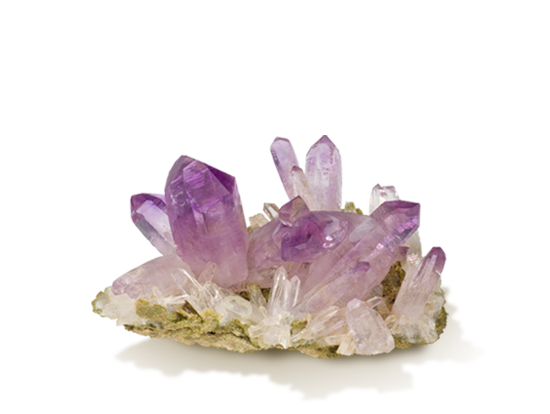OVERVIEW
Amethyst was as expensive as ruby and emerald until the 19th Century, when Brazil’s large deposits were discovered. It was believed to prevent intoxication—amethystos means “not drunk” in ancient Greek. Today, as the most valued quartz variety, amethyst is in demand for designer pieces and mass-market jewelry alike, and its purple to pastel hues retain wide consumer appeal.
Amethyst is the purple variety of the quartz mineral species. It’s the gem that’s most commonly associated with the color purple, even though there are other purple gems such as sapphire and tanzanite. Its purple color can be cool and bluish, or a reddish purple that’s sometimes referred to as “raspberry.”
Amethyst’s purple color can range from a light lilac to a deep, intense royal purple, and from brownish to vivid. Amethyst also commonly shows what is called color zoning, which in the case of amethyst usually consists of angular zones of darker to lighter color.
- Mineral: Quartz
- Chemistry: SiO2
- Color: Purple
- Refractive Index: 1.544 to 1.553
- Birefringence: 0.009
- Specific Gravity: 2.66
- Mohs Hardness: 7
WHERE IS IT FOUND ?
Russia was the major source of amethyst until the 19th century, when large deposits were found in Brazil. Once as rare as ruby or emerald, amethyst was suddenly in abundance. Today, the most important sources of amethyst are in Africa and South America. Brazil is still a major supplier, especially its southernmost state, Rio Grande do Sul, though the rough amethyst mined there tends to have a lighter color than amethyst found in other countries. Amethyst from Brazil sometimes forms in hollow, crystal-lined geodes so large you can stand in them.
The Anahí mine in Bolivia is another prominent source for amethyst. Hidden in the Pantanal wetlands, the Anahí mine is shrouded in fascinating lore. It was discovered by a Spanish conquistador in the 1600s, given to him as dowry when he married Anahí (a princess from the Ayoreo tribe), forgotten for three centuries, and rediscovered in the 1960s. The Anahí mine is also famous in gem circles as the source of the unusual bicolored amethyst-citrine crystals called ametrine.
CARE & CLEANING
Amethyst is a 7 on the Mohs scale of hardness. This means that it is appropriate for daily use in rings and other jewelry, but over time it may show wear and require repolishing. Because this February birthstone is more susceptible to damage than harder gems such as rubies, sapphires and diamonds, you risk scratching your amethyst jewelry if you place it next to these harder stones…
Heat treatment is the most common technique for improving the color and marketability of natural amethyst. Heat treatment can’t make pale amethyst darker, but it can lighten the color of very dark amethyst and make it more attractive. It can also remove unwanted brownish inclusions in some amethysts. Some amethyst turns yellow – to citrine – with heat treatment.
Amethyst birthstone jewelry can be cleaned with an ultrasonic cleaner, but steam cleaning is not recommended. A soft brush with mild soap is the safest option.
BIRTHSTONE
Amethyst is the birthstone for February and the gem for the 6th and 17th wedding anniversaries.
HISTORY
Because of its wine-like color, early Greek legends associated amethyst with Bacchus, the god of wine. Other legends reflected beliefs that amethyst kept its wearer clear-headed and quick-witted in battle and in business affairs. Because amethyst was associated with wine, it was believed that wearing amethyst prevented drunkeness.
Fine amethysts have been set in religious jewelry and royal crown jewels for ages. It was once considered equal in value to ruby, emerald, and sapphire. It’s no wonder that fine amethyst adorns the fingers of bishops as well as the coronation regalia of British royalty.
Amethyst is the birthstone for February and one of the emblems of the twelve apostles.
Source of Content : www.gia.edu


